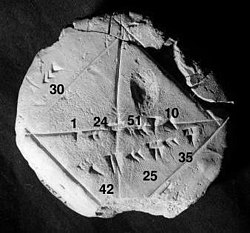Square root
In mathematics, a square root of a number x is another number that, when multiplied by itself (squared), becomes x. When it is not negative, it is represented by the symbol [math]\displaystyle{ \sqrt{x} }[/math], and called the principal square root of x.[1][2] For example, 3 is the square root of 9, because 3×3=9. Only numbers bigger than or equal to zero have real square roots. The square root of zero is zero.
An important number is the square root of 2, which is an irrational number. Its value is around 1.41421.[1] It is the length of a diagonal in the square whose side is 1.[3]
Square roots of negative numbers are not real numbers – they are imaginary numbers. Imaginary numbers are numbers whose square is negative. Every complex number, except 0, has two square roots that are imaginary numbers. For example, −1 has two square roots. We call them [math]\displaystyle{ i }[/math] and [math]\displaystyle{ -i }[/math]. We also consider the number [math]\displaystyle{ i }[/math] as the principal square root of −1, and call it the imaginary unit.
The sign for a square root is made by putting a bent line over a number. For example: [math]\displaystyle{ \sqrt 4 }[/math]. This is read as "the square root of 4".
A whole number with a square root that is also a whole number is called a perfect square. The first few perfect squares are: 0, 1, 4, 9, 16, 25, 36, 49, 64, 81, 100, 121, 144, 169, 196, 225, 256, 289, 324, 361, 400, 441, 484, 529, 576, 625, 676, 729, 784, 841, 900, 961, 1024, 1089, 1156, 1225.
Below is a table of square roots (rounded to 3 decimal places).
| Number | Square root of number |
|---|---|
| 1 | 1.000 |
| 2 | 1.414 |
| 3 | 1.732 |
| 4 | 2.000 |
| 5 | 2.236 |
| 6 | 2.449 |
| 7 | 2.646 |
| 8 | 2.828 |
| 9 | 3.000 |
| 10 | 3.162 |
| 11 | 3.317 |
| 12 | 3.464 |
| 13 | 3.606 |
| 14 | 3.742 |
| 15 | 3.873 |
| 16 | 4.000 |
| 17 | 4.123 |
| 18 | 4.243 |
| 19 | 4.359 |
| 20 | 4.472 |
Origin of the symbol
It is not really known where the square root symbol [math]\displaystyle{ \sqrt{\,\,} }[/math] comes from, but some people believe that it was from the letter r, which is the first letter of the Latin word radix (used in many languages). Radix means the root or base. Thus, radix quadratum from Latin refers most likely to the base of a square. Since the sides of a square are all equal, the word radix may be interpreted as meaning a side of a square.
Square Root Media
Constructing the length x = \sqrt{a}, given the a and the unit length
The Spiral of Theodorus up to the triangle with a hypotenuse of √17
Jay Hambidge's construction of successive square roots using root rectangles
Related pages
References
- ↑ 1.0 1.1 "Compendium of Mathematical Symbols". Math Vault. 2020-03-01. Retrieved 2020-08-28.
- ↑ Weisstein, Eric W. "Square Root". mathworld.wolfram.com. Retrieved 2020-08-28.
- ↑ "Irrationality of the square root of 2". www.math.utah.edu. Archived from the original on 2023-06-05. Retrieved 2020-08-28.
Other websites
- Table of square and square roots, 1-100 Archived 2009-02-08 at the Wayback Machine -The Math Forum







